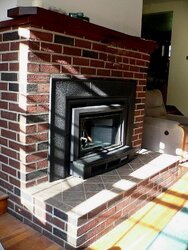- Nov 21, 2005
- 827
I got a company does full liner installs AND sweeps chimneys to sweep my chimney and see what they find because my draft is terrible. They didn't find anything wrong so, I told them about a possible crimp. They put mirrors to look up the liner and said there's a small one but it certainly is having very little impact on your draft. They also informed me, that if there was a crimp, most likely that spot would be full of creosote and there was hardly any. They also said if draft was affected they would've found more creosote. They only found 1/8" flakes around the ending 5 feet so, they told me it's burning especially clean if that's all there was after 4 cords.
They seemed to think there was minimal creosote for 4 cords, and the wood I burned must've been extremely dry... I know the wood was rather wet. They told me the only thing that could be is that my chimney is simply too short because a crimp would cause creosote in that location or cause more creosote to form later in the liner. With as little creosote as was in there, there isn't a restriction. Is that true a crimp would cause creosote in the location or later? My liner is 16 feet with my chimney ending around 14 feet above, my liner is sticks out a couple feet. Any other ideas or, is that all the symptoms of a short chimney. Smoke pours into the living area on reloads, difficulty in getting a fire going, starting a fire and leaving the door open a crack when I shut the door it can occasionally go out, unusually long burn times. They told me, if it took professionals 2 days to get the current liner in there, I certainly don't want to be taking it out and nothing with the liner appears to be the problem, has to be a short chimney. Your thoughts?
They seemed to think there was minimal creosote for 4 cords, and the wood I burned must've been extremely dry... I know the wood was rather wet. They told me the only thing that could be is that my chimney is simply too short because a crimp would cause creosote in that location or cause more creosote to form later in the liner. With as little creosote as was in there, there isn't a restriction. Is that true a crimp would cause creosote in the location or later? My liner is 16 feet with my chimney ending around 14 feet above, my liner is sticks out a couple feet. Any other ideas or, is that all the symptoms of a short chimney. Smoke pours into the living area on reloads, difficulty in getting a fire going, starting a fire and leaving the door open a crack when I shut the door it can occasionally go out, unusually long burn times. They told me, if it took professionals 2 days to get the current liner in there, I certainly don't want to be taking it out and nothing with the liner appears to be the problem, has to be a short chimney. Your thoughts?



 . I'm not sure if it's still true, but one used to be able to pick up vermiculite at better garden centers. I'm not sure about it's purity, but it's available on Amazon. Two half-bushel bags for $12.95. Be sure you get pure vermiculite and not a mix. One thing to note is that vermiculite can contain asbestos. They occur naturally together. For safety sake, treat it like it does, even if it doesn't.
. I'm not sure if it's still true, but one used to be able to pick up vermiculite at better garden centers. I'm not sure about it's purity, but it's available on Amazon. Two half-bushel bags for $12.95. Be sure you get pure vermiculite and not a mix. One thing to note is that vermiculite can contain asbestos. They occur naturally together. For safety sake, treat it like it does, even if it doesn't.